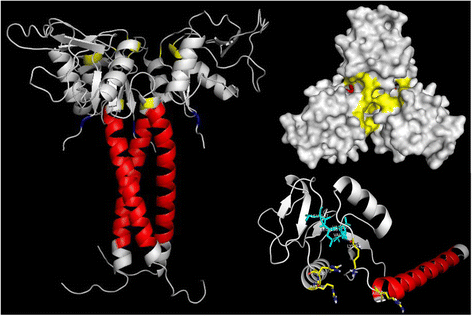Alpha-type phospholipase A2 inhibitors from snake blood
- PMID: 28344595
- PMCID: PMC5364564
- DOI: 10.1186/s40409-017-0110-2
Alpha-type phospholipase A2 inhibitors from snake blood
Abstract
It is of popular and scientific knowledge that toxins from snake venom (among them the PLA2 and myotoxins) are neutralized by various compounds, such as antibodies and proteins purified from animal blood. Venomous and nonvenomous snakes have PLA2 inhibitory proteins, called PLIs, in their blood serum. One hypothesis that could explain the presence of these PLIs in the serum of venomous snakes would be self-protection against the enzymes of their own venom, which eventually could reach the circulatory system. However, the presence of PLIs in non-venomous snakes suggests that their physiological role might not be restricted to protection against PLA2 toxins, but could be extended to other functions, as in the innate immune system and local regulation of PLA2s. The present study aimed to review the currently available literature on PLA2 and myotoxin alpha inhibitors present in snake plasma, thus helping to improve the research on these molecules. Furthermore, this review includes current information regarding the mechanism of action of these inhibitors in an attempt to better understand their application, and proposes the use of these molecules as new models in snakebite therapy. These molecules may help in the neutralization of different types of phospholipases A2 and myotoxins, complementing the conventional serum therapy.
Keywords: Myotoxin; Myotoxin inhibitor; Phospholipases A2; Snake blood; αPLI.
Figures

Similar articles
-
BoaγPLI: Structural and functional characterization of the gamma phospholipase A2 plasma inhibitor from the non-venomous Brazilian snake Boa constrictor.PLoS One. 2020 Feb 27;15(2):e0229657. doi: 10.1371/journal.pone.0229657. eCollection 2020. PLoS One. 2020. PMID: 32106235 Free PMC article.
-
Heterologous expression and biochemical and functional characterization of a recombinant alpha-type myotoxin inhibitor from Bothrops alternatus snake.Biochimie. 2014 Oct;105:119-28. doi: 10.1016/j.biochi.2014.07.001. Epub 2014 Jul 15. Biochimie. 2014. PMID: 25047442
-
Synergism between basic Asp49 and Lys49 phospholipase A2 myotoxins of viperid snake venom in vitro and in vivo.PLoS One. 2014 Oct 7;9(10):e109846. doi: 10.1371/journal.pone.0109846. eCollection 2014. PLoS One. 2014. PMID: 25290688 Free PMC article.
-
Snake venom phospholipase A2 inhibitors: medicinal chemistry and therapeutic potential.Curr Top Med Chem. 2007;7(8):743-56. doi: 10.2174/156802607780487614. Curr Top Med Chem. 2007. PMID: 17456038 Review.
-
A structure-based proposal for a comprehensive myotoxic mechanism of phospholipase A2-like proteins from viperid snake venoms.Biochim Biophys Acta. 2014 Dec;1844(12):2265-76. doi: 10.1016/j.bbapap.2014.09.015. Epub 2014 Sep 30. Biochim Biophys Acta. 2014. PMID: 25278377 Review.
Cited by
-
Preparation of monoclonal antibodies against gamma-type phospholipase A2 inhibitors and immunodetection of these proteins in snake blood.J Venom Anim Toxins Incl Trop Dis. 2017 Aug 3;23:37. doi: 10.1186/s40409-017-0128-5. eCollection 2017. J Venom Anim Toxins Incl Trop Dis. 2017. PMID: 28785278 Free PMC article.
-
Venom proteomic analysis of medically important Nigerian viper Echis ocellatus and Bitis arietans snake species.Biochem Biophys Rep. 2021 Nov 2;28:101164. doi: 10.1016/j.bbrep.2021.101164. eCollection 2021 Dec. Biochem Biophys Rep. 2021. PMID: 34765747 Free PMC article.
-
BoaγPLI: Structural and functional characterization of the gamma phospholipase A2 plasma inhibitor from the non-venomous Brazilian snake Boa constrictor.PLoS One. 2020 Feb 27;15(2):e0229657. doi: 10.1371/journal.pone.0229657. eCollection 2020. PLoS One. 2020. PMID: 32106235 Free PMC article.
-
Secreted Phospholipases A2 - not just Enzymes: Revisited.Int J Biol Sci. 2022 Jan 1;18(2):873-888. doi: 10.7150/ijbs.68093. eCollection 2022. Int J Biol Sci. 2022. PMID: 35002531 Free PMC article. Review.
-
A Comprehensive Multi-Omic Approach Reveals a Relatively Simple Venom in a Diet Generalist, the Northern Short-Tailed Shrew, Blarina brevicauda.Genome Biol Evol. 2020 Jul 1;12(7):1148-1166. doi: 10.1093/gbe/evaa115. Genome Biol Evol. 2020. PMID: 32520994 Free PMC article.
References
-
- WHO. WHO Expert Committee on Biological Standardization. 59th report. WHO Technical Report Series, no. 964. 2012. Available: http://www.who.int/biologicals/WHO_TRS_964_web.pdf. - PubMed
Publication types
LinkOut - more resources
Full Text Sources
Other Literature Sources

